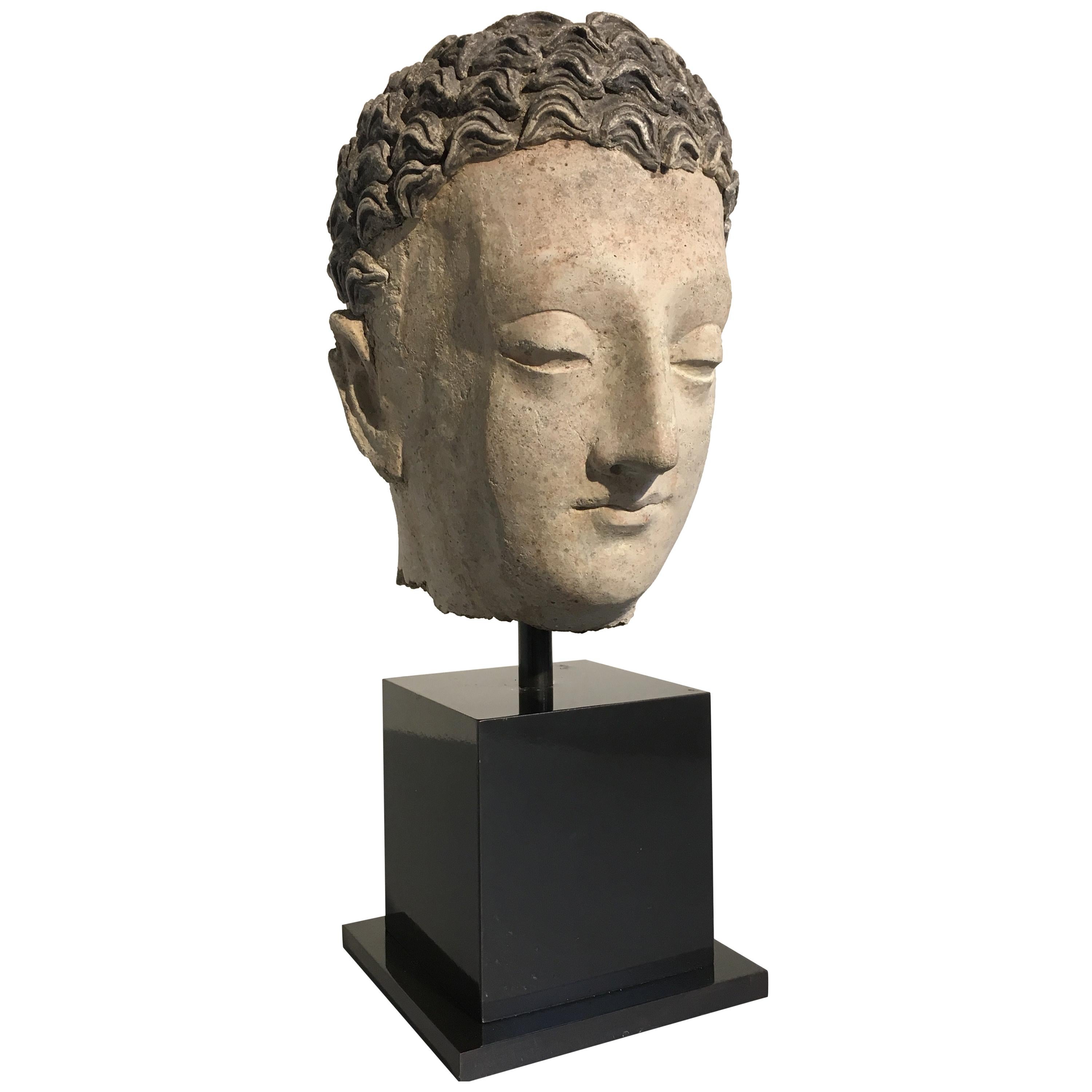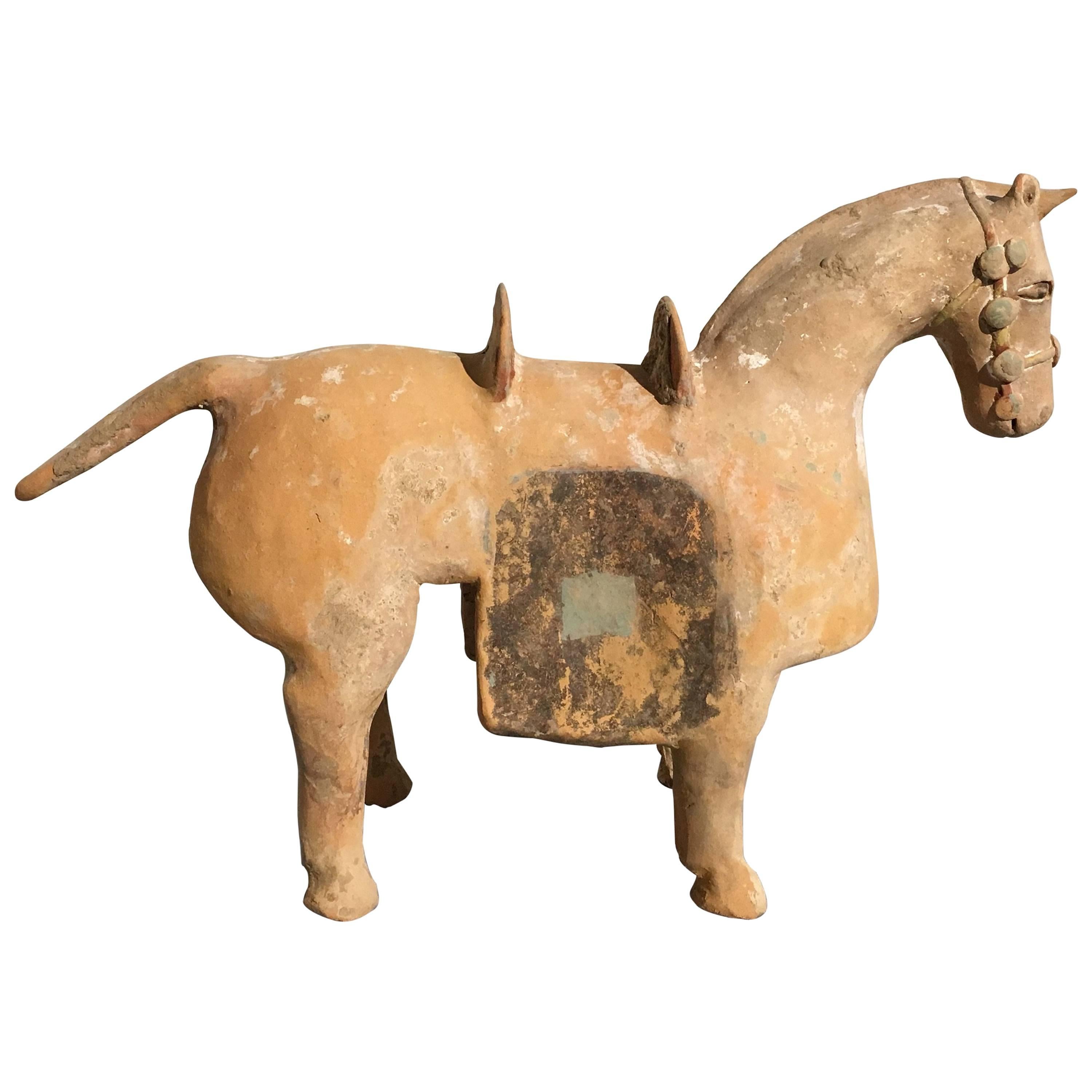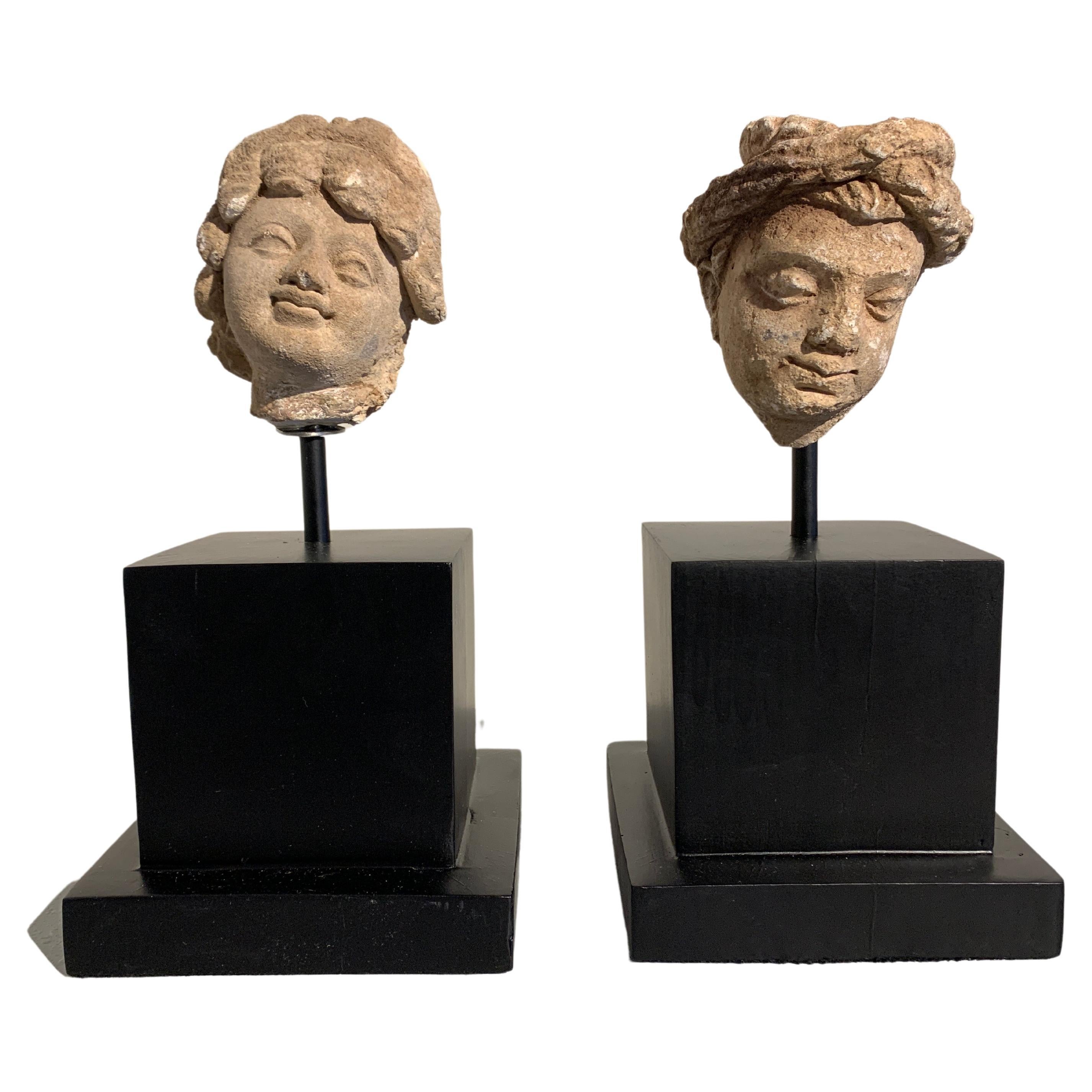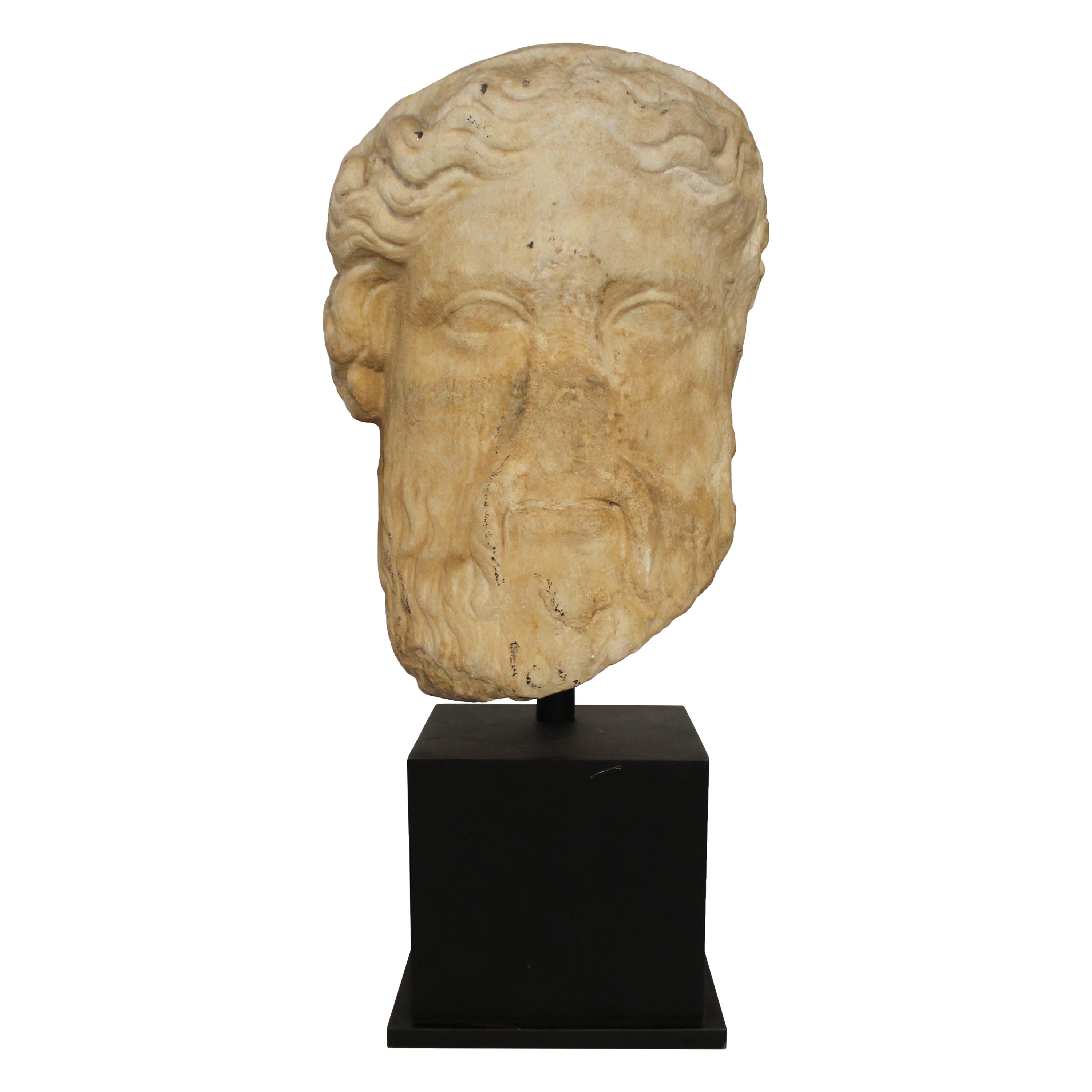Items Similar to Monumental Feminine Head - Roman Empire - 3rd-4th Century Ad
Want more images or videos?
Request additional images or videos from the seller
1 of 5
Monumental Feminine Head - Roman Empire - 3rd-4th Century Ad
About the Item
Very large feminine head crowned by a tiara
Roman period, 3rd - 4th century AD
Eastern provinces of the Roman Empire (Palmira?)
gray basalt
H 55 cm
Old collector's label visible in the lower right side.
Female head with idealized features. Despite the obvious characterization of oriental inspiration, this monumental head presents a stylistic language close to the Roman style diffused throughout the empire.
The hairstyle is elaborate with intertwined braids which were probably enriched by a tiara or a crown in metal or gold, as also testifies the visible hole in the upper part of the head.
The sculptures representing women presented a particularly rich ornamentation which re-elaborated fashions and models influenced by the Hellenistic and Roman West and by the Parthian and Sasanian East. This marriage of Eastern and Western motifs characterizes the unique originality of the art of Palmyra.
- Dimensions:Height: 21.66 in (55 cm)Width: 4.73 in (12 cm)Depth: 22.05 in (56 cm)
- Style:Greco Roman (Of the Period)
- Materials and Techniques:
- Place of Origin:Syria
- Period:
- Date of Manufacture:3rd-4th Century
- Condition:Wear consistent with age and use.
- Seller Location:Bruxelles, BE
- Reference Number:1stDibs: LU6666234375662
About the Seller
5.0
Vetted Seller
These experienced sellers undergo a comprehensive evaluation by our team of in-house experts.
1stDibs seller since 2022
6 sales on 1stDibs
Typical response time: 7 hours
- ShippingRetrieving quote...Ships From: Bruxelles, Belgium
- Return PolicyA return for this item may be initiated within 3 days of delivery.
More From This SellerView All
- Griffin Head, Italy, 16th CenturyLocated in Bruxelles, BEGriffin head Italy, 16th century On a modern metal stand Measures: 20 x 29 x 21 cm (without the stand) The griffin is a legendary creature with the body of a lion, the head an...Category
Antique 16th Century Italian Renaissance Animal Sculptures
MaterialsMarble
- Gothic crowned Head - Île de France, 14th centuryLocated in Bruxelles, BEHead of a crowned Virgin Île-de-France, first half of 14th century. H26 x 14 x 14 cm Provenance : - Private Collection, Paris France (1960) - Private Collection Tuscany, Italy (19...Category
Antique 15th Century and Earlier French Gothic Figurative Sculptures
MaterialsStone
- Telamon - Northern Italy, late 12th (Reemployed Roman marble)25000Located in Bruxelles, BETelamon Northern Italy, late 12th - early 13th century Reemployed Roman marble H 32 x L 18 x P 17 cm « Sono coloro che hanno dimenticato che l’uomo é solo un bruco, destinato a dive...Category
Antique 15th Century and Earlier Italian Medieval Figurative Sculptures
MaterialsMarble
- Roman Corinthian Capital, Flavian Period, 1st Century ADLocated in Bruxelles, BERoman corinthian capital Marble Flavian period, 1st century AD H 40 x L 42 x P 40 Provenance : Private collection United Kingdom.Category
Antique 15th Century and Earlier Italian Classical Roman Architectural E...
MaterialsMarble
- Marble Roman relief representing a ChristogramLocated in Bruxelles, BEMarble Roman relief representing a Christogram Roman relief - 4th century 25 x 22 x 8 cm Provenance : Collection of the Château de B. À Nevers by Georges C.S., scholar born in 1833 and deceased in 1909 The entire castle and its collections were acquired in 1938 by the current owners of the estate A christogram is a monogram or combination of letters that forms an abreviation for the name of Jesus Christ. This rare fragment combines chi (X) and rho (P), the first two letters of Christ's name in Greek and it is one of the oldest and most popular early christian symbol. The monogram of Christ, or chrismon, is also a powerful symbol of imperial victory: it appeared to Emperor Constantine the Great before his battle against Maxentius in ad 312, promising victory in the name of Christ. In Plato's Timaeus, it is explained that the two bands which form the "world soul" (anima mundi...Category
Antique 15th Century and Earlier Italian Classical Roman Figurative Scul...
MaterialsMarble
- Cerberus, Italy, 17th CenturyLocated in Bruxelles, BECerberus Black painted stone Italy, 17th century Measures: 80 x 69 x 36cm (one head missing) Cerberus, cruel monster, fierce and strange, Through his wide threefold throat barks as a dog Over the multitude immers'd beneath. His eyes glare crimson, black his unctuous beard, His belly large, and claw'd the hands, with which He tears the spirits, flays them, and their limbs Piecemeal disparts (Dante, Inferno, Canto VI). Cerberus figure seated, in his role of ferocious guardian of the underworld; he shows a nervous musculature, an adherent skin which reveals the ribs, long and robust limbs; his heads are broad and the eyes set well apart. Painted in black to amplify his menacing look, the infernal guardian is depicted with his famous attributes, writhing his heads, growling and barking furiously. Cerberus, in Greek mythology, was the monstrous watchdog of the underworld – also known as the “hound of Hades” – preventing the dead from leaving, and making sure that those who entered never left. A child of Typhon and Echidna, he was part of a monstrous family, which included Orthus, the Lernaean Hydra, and the Chimaera as well. Only on three occasions Cerberus was tricked by visitors of Hades: Heracles did it with his strength, Orpheus with his music. In "The Inferno", Dante places Cerberus as the guardian of the third circle of Hell. With his three mouths, Dante saw Cerberus as a beast that was synonymous with the sin of Gluttony. Virgil gets past the monster by throwing mud in his three mouths, temporarily choking him. Very rare are the representations of Cerberus in ancient statuary...Category
Antique 17th Century Italian Renaissance Figurative Sculptures
MaterialsStone
You May Also Like
- Gandharan Stucco Head of the Buddha, 3rd-5th CenturyLocated in Austin, TXA sublime Greco-Buddhist stucco head of the Buddha, ancient region of Gandhara, circa 3rd-5th century. A fragment of a larger statue, the Buddha's face...Category
Antique 15th Century and Earlier Pakistani Figurative Sculptures
MaterialsStucco
- Chinese Six Dynasties Pottery Model of an Armored Horse, 3rd-4th Century, ChinaLocated in Austin, TXAn extremely rare Chinese painted pottery model of an armored horse, Six Dynasties period (220-581 AD), TL tested by Oxford Authentication. The stocky ...Category
Antique 15th Century and Earlier Chinese Antiquities
MaterialsPottery
- Pair Gandharan Stucco Heads of Donors, 3rd-5th Century, GandharaLocated in Austin, TXA charming pair of Gandharan molded stucco heads of donors, ancient region of Gandhara (modern day Pakistan / Afghanistan), probably Taxila, circa 3rd-5th century. The two heads most likely represent donors. Donors to temples would often have their images enshrined in the artworks of temple walls in thanks for their support. One head portrays a youthful figure with a plump, smiling face, and full head of hair arranged in fat curls and secured by a headband. The androgynous figure...Category
Antique 15th Century and Earlier Pakistani Hellenistic Antiquities
MaterialsWood, Stucco
- Original Antique (3rd Century AD) Roman Carved Agate IntaglioLocated in Chicago, ILIntaglio is a technique which dates back to antiquity and is still in use today. Images are carved or engraved in gemstones leaving a hollow impression in the untouched background. T...Category
Antique 15th Century and Earlier Italian More Furniture and Collectibles
MaterialsAgate
- Gandharan Stucco Head of a Bodhisattva, Region of Hadda, 3rd-5th CenturyLocated in Austin, TXA striking Gandharan molded stucco head of a male Bodhisattva, tentatively identified as Manjushri, ancient region of Gandhara, probably Hadda or surrounding area, 3rd-5th century. The Bodhisattva is sculpted of stucco in an idealized manner as a youthful male, with soft and kind features, a benign expression on his face. He wears an elaborate pleated turban wrapped around his head, with two sweeping lobes at the front. His turban secured on one side by a small image of a roaring lion. The lion may be read as a reference to Manjushri, the Bodhisattva of Wisdom, who is often depicted as riding or subduing a roaring lion, a metaphor for taming the wild thoughts of the mind. Manjushri gazes outwards in a beatific manner from almond shaped eyes, a gentle smile on his lips. The eyes at different levels when looking at the sculpture head on, indicating the original placement of the head was meant to be viewed at an angle. Remnants of pigments to the eyes, nose, mouth and ears. Mounted on a custom black metal stand. Hadda was an important center of Buddhist learning in the early history of Greco Buddhist Gandhara, and at one time may have housed a bone relic of the historical Buddha, Shakyamuni. The sculpture and architecture of Hadda followed Hellenistic artistic conventions faithfully, leading some scholars to believe the distinct Greco Buddhist style of Gandhara was first developed in Hadda before spreading to the rest of the region. The kingdom of Gandhara was situated at a crossroads of trade and cultures. Being one of the last remnants of Alexander the Great's Empire, the inhabitants of the Greco-Bactrian Buddhist kingdom preserved Greek culture and heritage for centuries after the decline of the Greek Empire...Category
Antique 15th Century and Earlier Afghan Hellenistic Sculptures and Carvings
MaterialsStucco
- Hermes Head Sculpture, 4th Century, GreeceLocated in Girona, SpainHermes head sculpture. Greek Bust representing Hermes. Hermes is an Olympian deity, the God of Speed, in ancient Greek religion and mythology. Sculpted ...Category
Antique 15th Century and Earlier Greek Classical Greek Busts
MaterialsMarble, Stone, Metal
Recently Viewed
View AllMore Ways To Browse
Hermes God Helmet
J Philippe Bronze Statue
Greek Hermes Sandals
Hermes Bath Set
Hermes Greek God Sandals
Marble Statue Of Roman Soldier
Vintage Breeze Blocks
Virgin And Child Statue Italy
Yard Gnomes
Ancient Greek Hermes Statue
Antique African Wooden Statues
Antique Bisque Piano Baby Figurines
Antique Pewter Goblet
Antique Pewter Goblets
Buste Femme Antique
Greek God Hermes Helmet
Hermes Adding Machine
Hermes Ancient Greek Statue





